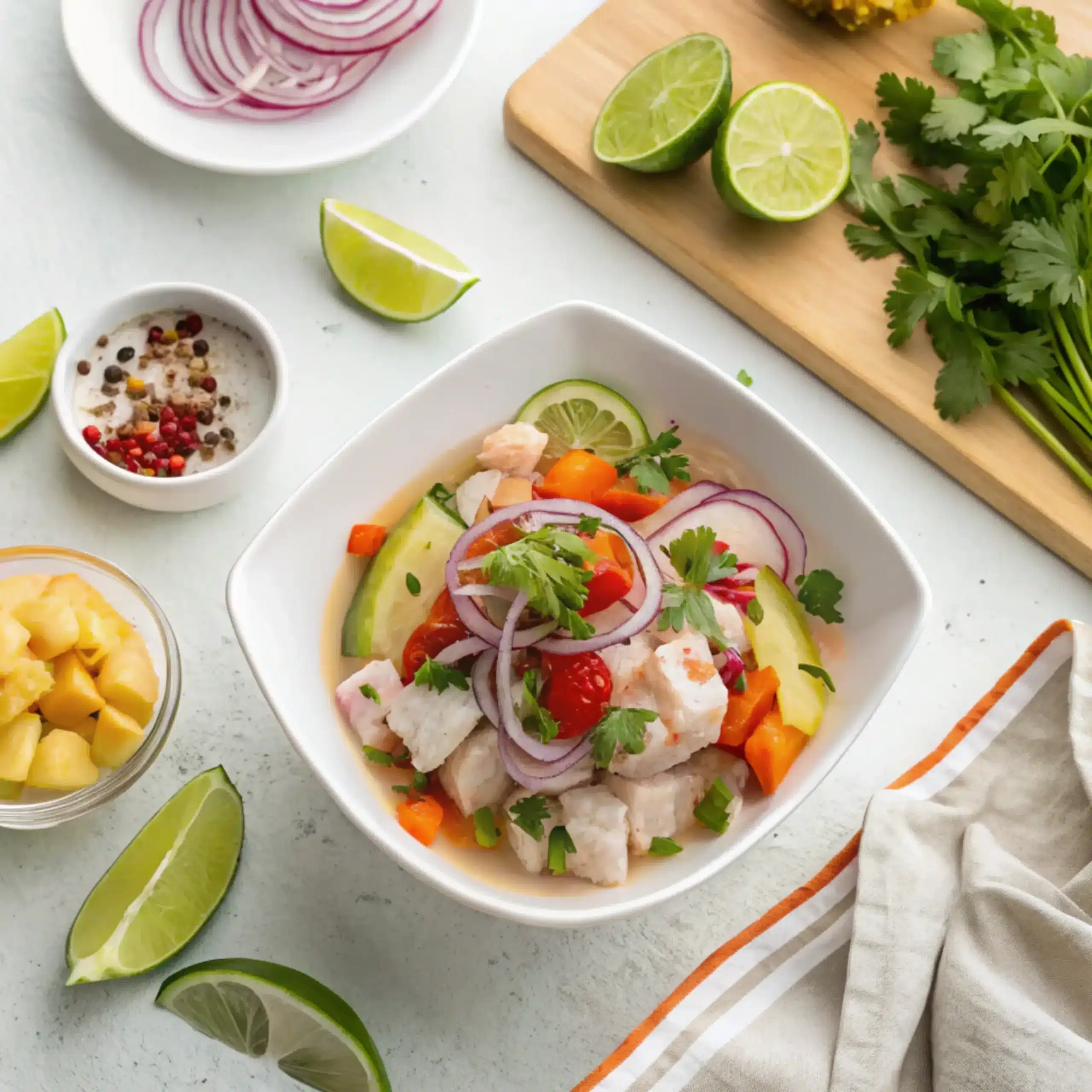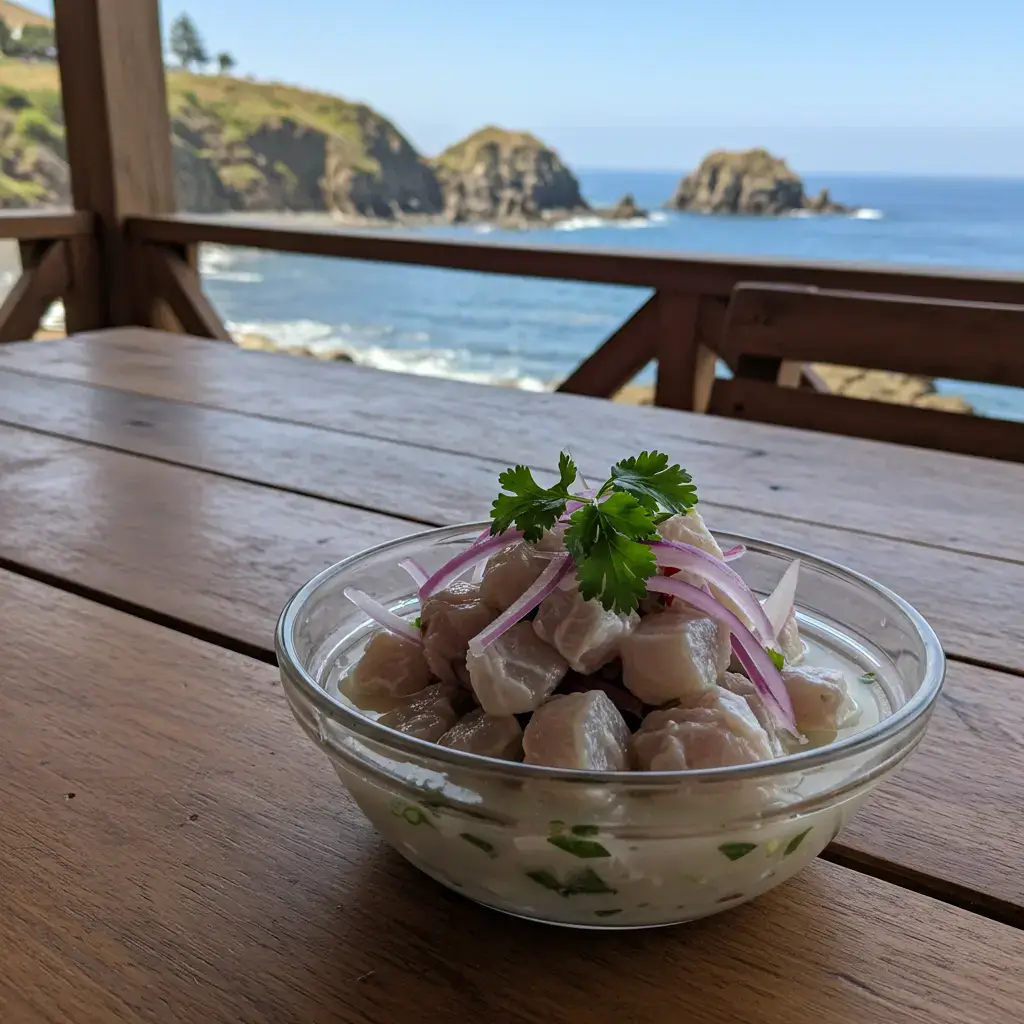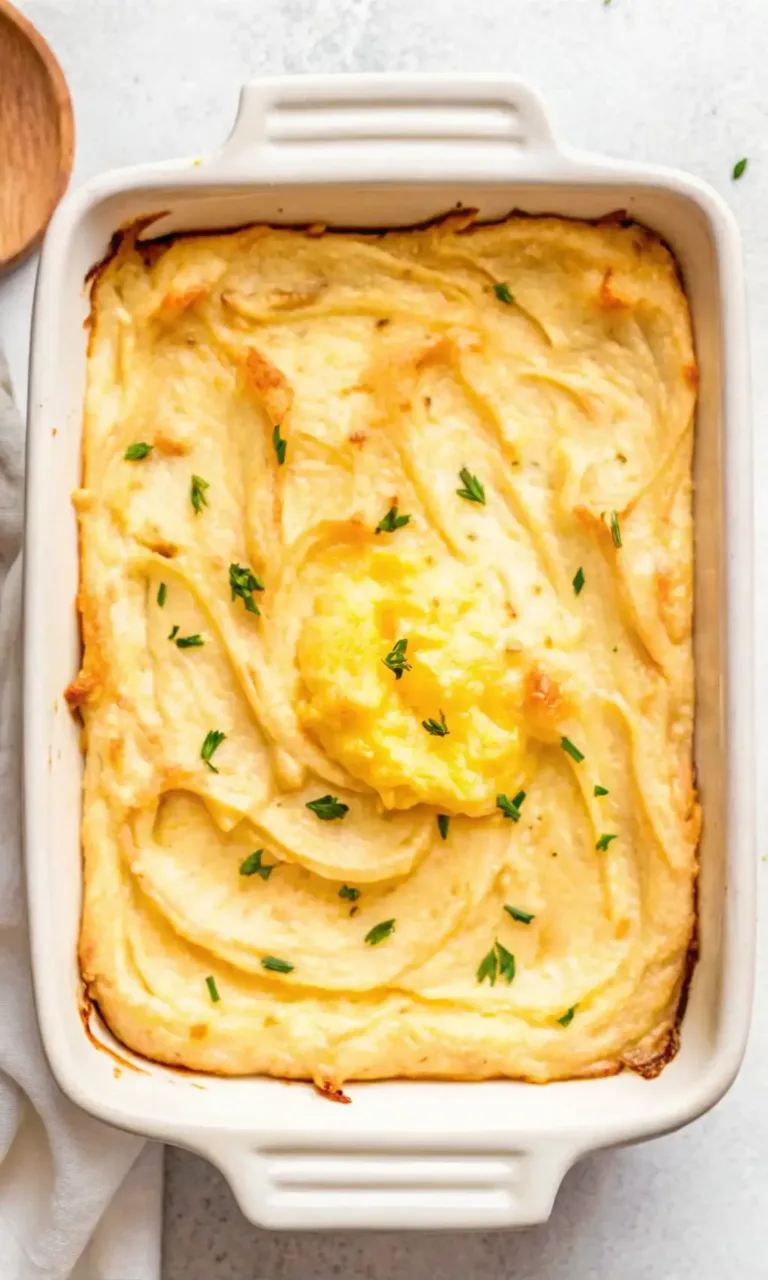Chilean Ceviche: A Fresh, Soulful Taste of the Pacific
The Story & Intro – My Love Affair with Chilean Ceviche
I first tasted Chilean ceviche on a breezy afternoon just outside Valparaíso, where the cold Pacific met a fisherman’s market bustling with locals. A weathered vendor handed me a paper cup filled with chunks of reineta, marinated in citrus, kissed with heat, and bright with cilantro. One bite and I was hooked. It wasn’t just a dish—it was a feeling. Sharp, clean, and soulful.

Back home in the Blue Ridge, I craved that same brightness when summer rolled around. As someone who teaches home cooking through my supper club, Copper & Thyme, I believe in food that’s simple, rustic, and memory-laced. And Chilean ceviche checks all those boxes. It’s a celebration of the sea, and in my kitchen, it’s become a staple when I want something light, seasonal, and full of character.
The best part? You don’t need fancy skills or a deep-sea catch to make it. With a few fresh ingredients and the right timing, this dish becomes a showstopper on any table. Whether served in small cups as an appetizer or heaped on crisp lettuce as a main course, Chilean ceviche makes an impression—just like it did on me that day by the water.
You’ll find ceviche variations across South America, but Chile’s take is uniquely subtle. Compared to the sharper flavors of its Peruvian cousin, this version leans gently on lime, letting the quality of the fish and freshness of the herbs shine through.

Chilean Ceviche: A Fresh, Soulful Taste of the Pacific
Ingredients
Method
- 1. Dice fish into small cubes and place in glass bowl.
- 2. Pour lime juice over fish and marinate in fridge for 15–20 minutes.
- 3. Stir halfway to ensure even curing.
- 4. Add red onion, cilantro, and chili.
- 5. Season with salt and mix gently.
- 6. Serve immediately with sides or in avocado halves.
Nutrition
Notes
Tried this recipe?
Let us know how it was!Table of Contents
Ingredients & Preparation – Simple, Seasonal, and Soulful

What Goes Into Authentic Chilean Ceviche?
What I love about Chilean ceviche is that it doesn’t hide behind layers of spice or technique. It begins with fish—fresh, local, and firm. In Chile, reineta or congrio (conger eel) are common, but back in North Carolina, I go with sea bass, snapper, or halibut—whatever’s freshest and wild-caught.
You’ll also need freshly squeezed lime juice, finely sliced red onion, chopped cilantro, and a bit of ají amarillo or red chili for mild heat. Some versions add a splash of olive oil or a few kernels of corn, but the spirit of the dish remains unchanged: raw fish cured in citrus, enhanced by the simplest of ingredients.
If you’re building a seasonal menu, ceviche pairs beautifully with fresh starters like those in my salad and starters collection—light, crisp, and made to share.
How to Make It Right Every Time
Ceviche is all about timing. Too short, and your fish stays raw. Too long, and it goes rubbery. The key? Balance and intuition. Here’s my go-to step-by-step:

- Dice 1 lb of fresh white fish into small, even cubes.
- Place it in a non-reactive bowl with ¾ cup fresh lime juice.
- Let it marinate in the fridge for 15–20 minutes, stirring once halfway through.
- Add ½ cup thinly sliced red onion, 2 tbsp chopped cilantro, and sliced chili to taste.
- Season lightly with salt. Serve immediately.
| Fish Type | Marination Time |
|---|---|
| Sea Bass / Snapper | 15–20 minutes |
| Halibut | 20–25 minutes |
| Conger Eel | 10–15 minutes |
Cultural Relevance & Variations Across Chile
Regional Flavors of Chilean Ceviche
While Chilean ceviche stays true to its foundation—cured fish, citrus, and aromatics—every region adds its own spin. Along the central coast near Valparaíso, ceviche is often light and lime-forward, made with reineta or hake, and served in seaside cafés in generous glass bowls. Travel south toward Chiloé or Patagonia, and you’ll find coldwater shellfish like mussels or scallops folded into the mix.
One of my favorite regional twists came from a friend in Temuco who used smoked merken (a Mapuche chili spice) to finish her ceviche—adding a warm, earthy note to the bright flavors. Others swap out traditional lime for a touch of grapefruit or even orange juice for a milder acid.
The beauty of Chilean ceviche is that it travels well across the country—and into your kitchen—without losing its soul. It adapts to what’s fresh, seasonal, and available, just like the dishes I love to teach at Copper & Thyme. And whether you’re using reineta or red snapper, its simplicity makes it approachable for home cooks and food lovers alike.
Ceviche vs. Other Latin Versions
To understand Chilean ceviche, it helps to see how it compares with its better-known cousins. Peruvian ceviche, for instance, is boldly acidic and includes leche de tigre—a seasoned citrus marinade that’s often served as a drink or a shot. Ecuadorian ceviche sometimes includes tomato juice or ketchup, giving it a slightly sweet, soupy quality.
By contrast, Chilean ceviche is quieter. It uses less citrus, skips the leche de tigre, and lets the fish rest just long enough to take on flavor without losing texture. It’s clean and minimalist, much like many of the rustic starters I prepare at home—where less is more, and every ingredient matters.
Looking through our blog, you’ll find similar recipes that reflect this soulful, seasonal approach. From appetizers to mains, the spirit of Chilean cooking—especially ceviche—is alive in every bite
Serving, Pairings & Leftovers
How to Serve Chilean Ceviche the Traditional Way
When it comes to plating Chilean ceviche, you can keep it rustic or dress it up—it shines either way. In coastal Chile, it’s often served in simple glass bowls or in lettuce cups that double as edible scoops. I’ve seen it nestled in avocado halves or spooned over grilled toast like bruschetta. For dinner parties, I love presenting it on a chilled platter, surrounded by slices of lime and sprigs of cilantro.

Whether you’re feeding a crowd or keeping it cozy, the goal is the same: let the freshness speak. No heavy sauces, no garnish overload. Just bright flavors, clean lines, and something crunchy on the side—like plantain chips, corn nuts, or thin-sliced radish.
Perfect Pairings: What to Eat & Drink with Ceviche
Ceviche pairs naturally with sides that match its brightness. Think roasted sweet potatoes with sea salt, a light quinoa salad with citrus vinaigrette, or steamed corn with lime butter. You can even serve it alongside a chilled seafood soup or crisp starter salad to round out the meal.
For drinks, I always suggest a glass of Chilean Sauvignon Blanc—it mirrors the ceviche’s acidity and herbal tones perfectly. If you’re leaning toward something stronger, a classic pisco sour complements the dish with just enough tang and lift.
Have leftovers? Store the ceviche (without onion, if possible) in an airtight container for up to 24 hours. Keep in mind: once the fish is fully “cooked” by the citrus, the texture changes. It’s still delicious, but best enjoyed fresh.
Conclusion
Whether you’re standing by the ocean in Valparaíso or prepping dinner in a small-town kitchen like mine outside Asheville, Chilean ceviche brings the sea to your table with honesty and soul. It’s one of those rare dishes that feels both elegant and easy, rooted in culture but adaptable to your own rhythm.
For me, it’s more than just a recipe. It’s a reminder that simplicity, when done with care, is never boring. With just a handful of ingredients and a little trust in the process, you can create something truly vibrant—something that surprises, nourishes, and lingers.
So grab your sharpest knife, your juiciest limes, and your freshest catch. Your ceviche story starts here. And as always—there’s a seat at my table for you.
For more Recipes Follow me in : Pinterest
FAQ Section
What is the country of origin of ceviche?
Ceviche is widely believed to have originated in Peru, where it’s considered a national treasure. Over time, different Latin American countries—like Chile, Ecuador, and Mexico—have developed their own regional variations. Chilean ceviche stands out for its softer citrus notes and minimalist approach.
Which country’s national dish is ceviche?
Ceviche is the national dish of Peru. However, it plays a central role in many coastal cuisines across South America. While not Chile’s official national dish, Chilean ceviche is still a beloved staple along the country’s vast Pacific coast, especially in regions like Valparaíso and Chiloé.
Do they eat ceviche in Chile?
Absolutely. Chilean ceviche is a popular and traditional seafood dish enjoyed year-round, particularly in coastal towns. Unlike the Peruvian version, Chile’s version is gentler on citrus and often includes local touches like smoked merken or shellfish.
What is ceviche?
Ceviche is a dish made by marinating raw fish or seafood in citrus juice, typically lime or lemon. The acid “cooks” the fish, changing its texture and flavor. In Chilean ceviche, this process is milder and usually enhanced with red onion, cilantro, and a touch of chili for balance.






